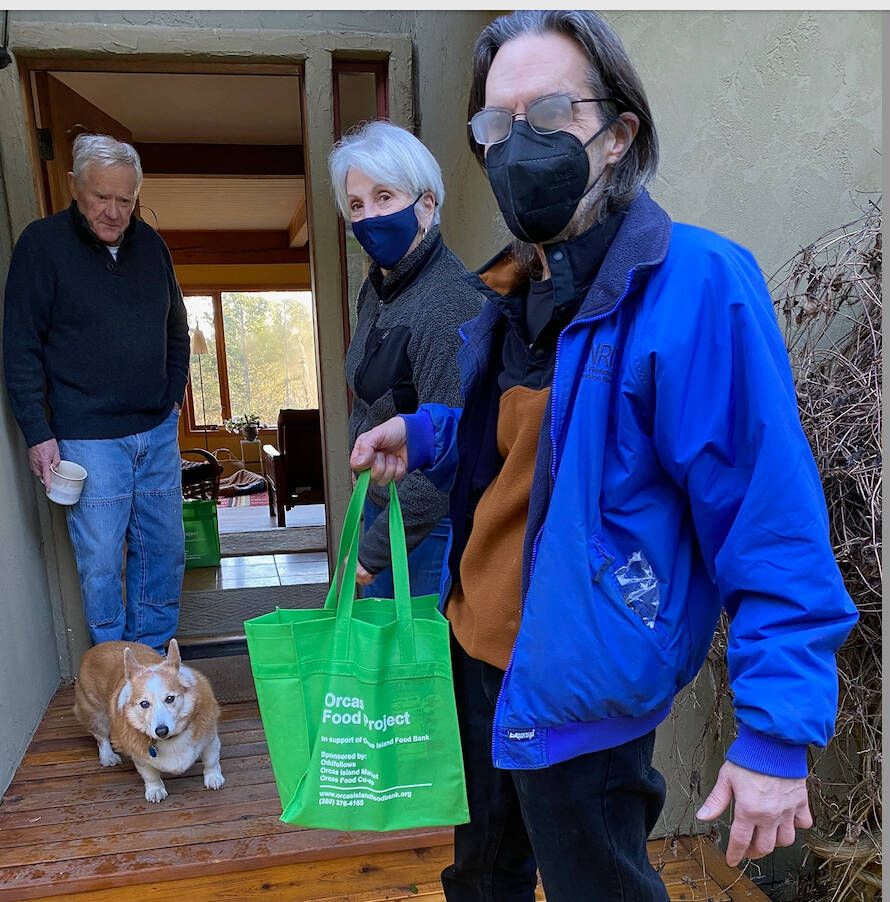by Geri Turnoy
Special to the Sounder
“Food costs a fortune” has become a frequent refrain. We may not be able to fix that, but an easy way for you to help meet the nutritional needs of Orcas Island residents who don’t have a fortune is through the Orcas Food Project. Launched in October 2021, this project, which was rolled out in only nine neighborhoods, has already resulted in the donation of 1,390 pounds of food to the Orcas Island Food Bank. The program is patterned after the Ashland Food Project in Oregon, which was founded in 2009 and subsequently replicated in at least 70 towns and neighborhoods throughout the country. The Oddfellows played the leading role in getting the Project started here.
This is how it works.
You sign up and agree to donate specified non-perishable food items every other month.
We give you a reusable collection bag with a shopping list of items currently needed by the Food Bank and connect you with a nearby neighborhood coordinator (NC).
Your NC picks up the filled bag from your front porch on the second Sunday of even-numbered months and drops off an empty bag with the new food list. Upcoming collection Sundays are April 10 and June 12. You have two months to fill your bag, even if you know that you’ll end up shopping the night before. Many donors add an item or two for the Food Bank each time they shop.
The NCs, who typically collect from up to 20 homes, deliver the filled bags to the Food Bank the next morning.
After reading this, some of you may feel compelled to sign up to be a neighborhood coordinator as well as a donor. If you’d like to be a neighborhood coordinator and/or a food donor, please call me, Geri Turnoy, at (360) 376-4165, text me at (503) 548-7845, or email me at davidgeri@rockisland.com.
Donors are asked to stick to the list, which the Food Bank compiles by surveying customers on what they want/need that is not supplied by other sources — and because the Food Bank’s limited shelf space is incompatible with a hodgepodge of products. Many participants have discovered that their children enjoy being involved in the shopping. It’s a good way to model and teach compassion and community service from an early age.
As we all know, necessities such as food, housing, heating, and gasoline are expensive on Orcas Island. When forced to choose between good nutrition and paying other bills, some people move to the mainland. That leaves jobs here unfilled, reducing everyone’s quality of life. By participating in the Orcas Food Project, you can help people live here and live healthy. We encourage food donors to buy from local markets, adding another boost to the island economy.
Based on income level, about 50% of OI residents qualify for assistance at the Food Bank. Thus, the need for food assistance is great, and the potential for the Food Project to add to what the Food Bank receives from government agencies, grants, and private donations is significant. To date, we have NCs in these neighborhoods: Orcas Highlands, Olga, Doe Bay, Deer Harbor (Spring Point), Eastsound (Wild Rose Meadow, Lavender Hollow), Victorian Valley, and North Beach. You can help unleash the Project’s potential by becoming a coordinator in your own neighborhood. Neighborhood coordinators play a key role in collecting food and are essential to achieving one of the other outcomes reported by the Ashland Food Project — “creating new neighborhood connections and strengthening our community.”
We hope you’ll soon see Orcas Food Project green tote bags on porches in your neighborhood. We thank our sponsors — Orcas Island Market, Orcas Food Co-op, and the Oddfellows — for donating the funds to buy these bags.
For more details about the Orcas Food Program, please visit orcasislandfoodbank.org and click on “Programs.”



